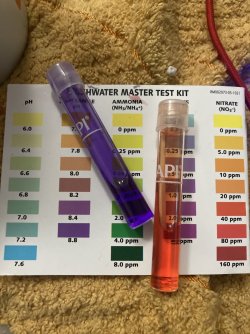You have made a lot of posts recently. All the post combined, gives a hint of a uncycled new tank. You say that you have changed the filter, do you still have the old filtersponge?
When you say that you completely cleaned the 2.5 gallon tank, what do you mean by that? If you have removed all the water, new filter, gravel etc. then you will also have ammonia spike in that tank.
Ammonia gets broken down by beneficial bacteria. Those bacterias mainly attaches to your filter and biomedia (ceramic rings etc.). Ammonia doesnt attach to anything, but is flowing around in the water. That means if you do a 50% water change, you will reduce the ammonia by 50ish%. - This does not mean, that a 100% water change will solve you problems

-
Plants will use ammonia and nitrates as their "food". A fast growing plant like sessiliflora or guppy grass "eats" ALOT, whereas Anubias grows slowly, and therefore consumes less nutrients.
But to answer your question: Daily water changes of 30% - 50% until 0 ppm ammonia consistently. Add fast growing plants, surface plants and stem plants are both very good (hygrophila polysperma, limnophila sessiliflora and anacharis, are all excellent and most stores have them).
Your shrimps will without a doubt thank you, if you get some guppy grass or java moss for them to hide in.



